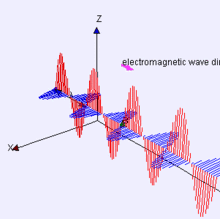I am trying to build a circuit that turns on a LED diode when it detects AM radio waves, in order to create a "radio wave detector".
Before I explain further, please note that I am not trying to power the LED solely using RF power from the air. In fact, this wouldn't be possible because I read that radio waves that we pick up are typically around 50-100 μV. Thus, it wouldn't be possible to power the LED using just this power.
Instead, what I want to do is amplify the relatively faint AM radio signal using extremely basic components like a transistors (i.e. BC547) and 9V battery, so that the LED turns on when the circuit picks up AM radio waves.
I'm pretty new to electronics, and so for the sake of simplicity, we can keep this circuit permanently tuned to 1000 KHz (as an example) so that we don't need variable inductors or capacitors for the LC circuit. Furthermore, I don't need any fancy features – just a most basic AM radio wave detector using some simple parts (no IC's please!).
I spent a lot of time on the internet trying to learn how to do this, but I haven't been able to find any examples of this. Something useful that I did find, however, is a "single-transistor radio" (ex: this link). I followed instructions for these types of radios (but I replaced the speaker with an LED), my LED just remains lit the whole time, regardless of whether or not the antenna picks up radio waves. I just want it to light up when it picks up radio waves (which can be tested by connecting and disconnecting the antenna?).
How do I build a switch that can be activated with RF?

Best Answer
The following lists a few simple AM receivers of potential use for your application.
In each case an AC coupled audio signal is the usually provided output. You will need to either observe changes in the operating point of the following audio stage with an unmodulated carrier is received (see below) OR derive output from the preceding stage. A simple comparator (see below) can then be used to provide a high/low signal.
_______________________________
Here is a better starting circuit than many from here - which includes a good description and components list.
It is "better than many" as it is "regenerative" - the audio is fed back from Q2 via R1 to the input stage so that the pair act both as RF and audio amplifier.
Audio only is fed via C3 to Q3.
Here the fun begins.
You will see a change with unmodulated carrier but I do not know of what magnitude.
The voltage across R5 will vary and may be used to trigger a comparator. It MAY prove easier to use the signal level change at Q2 collector, DC couple that to a Q3 stage and then use a comparator.
(Sorry for the uncertainties - easier to play and observe than cudgel brain on practical results of regen with unmodulated carrier).
______________________________________
A comparator consisting of a "long tailed pair" will allow a variable DC level signal to turn an LED on and off. Many long tailed pair references here
This simple circuit from here will work very well as a DC comparator. The webpage provides a good discussion of LTPs.
In this simple case, when say TR1 base is at a higher voltage than TR2 base, TR1 turns on, taking the majority of the current via R1 (which is a current source in more complex designs) and regeneratively proting Tr1 on and Tr1 off. So, Voltage at TR1_C (V_TR1_C)falls and V_TR2_C rises and an LED may be drive thereby.
An even simpler regenerative receiver.
Replace LM386 stage as above. From here but registration required. Detail may or may not be available. Note regen control seems to be by moving a pickup loop on tuned circuit.
_________________________________
Also worth a look - a "superregenerative" receiver. Input is driven in and out of regeneration at above audible (usually :-) ) rate to allow sensitivity to be optimised. From here